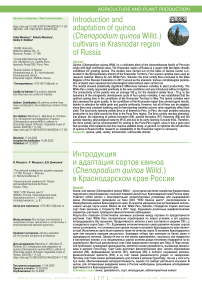Introduction and adaptation of quinoa (Chenopodium quinoa Willd.) cultivars in Krasnodar region of Russia
Автор: Mendoza V., Mendoza R., Dmitriev D.V.
Журнал: Овощи России @vegetables
Рубрика: Общее земледелие, растениеводство
Статья в выпуске: 6 (74), 2023 года.
Бесплатный доступ
Quinoa (Chenopodium quinoa Willd.) is a cultivated plant of the Amaranthaceae family of Peruvian origin with high nutritional value. The Krasnodar region of Russia is a region with favorable climatic conditions for growing quinoa. The studies were carried out on the basis of Quinoa Center LLC, located in the Novokubansky district of the Krasnodar Territory. Four quinoa varieties were used as research material: Blanca de Juli, White Peru, Salcedo, the local variety Seva (included in the State Register of the Russian Federation in 2017) served as the standard. Various morphological parameters of plants were assessed and phenological observations were carried out. The results showed statistically significant differences between varieties in plant productivity. The White Peru variety responded positively to the new conditions and was introduced without irrigation. The productivity of the panicle was on average 100 g, for the standard variety Seva - 70 g. In the dynamics of the ontogenetic development cycle of four quinoa varieties, it was established that the optimal sowing time in the conditions of the Krasnodar Territory is May. The tested varieties were also assessed for grain quality. In the conditions of the Krasnodar region they showed good results, thanks to selection for white grain and panicle uniformity. However, not all of them can be adapted, since they need constant watering and for late-ripening varieties autumn rains negatively affect their yield. The local early ripening variety Seva is of interest to Peru. In Peru, the main problem reducing production is low yield caused by frost in the Puno Peru region. The Seva variety reaches phenological phases: the beginning of panicle formation (R6), panicle formation (R7), flowering (R8) and full panicle ripening, physiological maturity (R12) and due to its early ripening it avoids frost. Therefore, the Seva variety can be recommended for sowing in the Puno-Peru region, since it has a gene pool that provides cold resistance but this requires detailed study. In general, to optimize the introduction of quinoa in Russia further research on adaptability in the Krasnodar region is necessary.
Quinoa, yield, variety, introduction, unfavorable climate
Короткий адрес: https://sciup.org/140303340
IDR: 140303340 | УДК: 633.1:631.526.32:631.524(470.62) | DOI: 10.18619/2072-9146-2023-6-117-122
Список литературы Introduction and adaptation of quinoa (Chenopodium quinoa Willd.) cultivars in Krasnodar region of Russia
- Jacobsen S.E., Mujica A., Ortiz R. La importancia de los cultivos andinos Fermentum. Revista Venezolana de Sociología y Antropología. 2003;13(36):14–24. https://www.redalyc.org/pdf/705/70503603.
- Alandia G., Rodriguez J.P., Jacobsen S.-E., Bazile D., Condori B. Global expansion of quinoa and challenges for the Andean region. Global Food Chemistry. 2020;(26):100429. https://doi.org/10.1016/j.gfs.2020.100429.
- Jaikishun S., Li W., Yang Z., Song S. Quinoa: In the light of global challenges. Agronomy. Argentina. 2019;(9):176. https://doi.org/10.3390/agronomy9040176.
- Statistical data of the Government of PERÚ MIDAGRI https://www.gob.pe/midagri
- Campos A., Cabrera P., Pérez C., Laura C. Tendencia del mercado y la producción de los productos orgánicos en el Perú. Rev. invest. Altoandino. 2017;19(4):427–431. http://dx.doi.org/10.18271/ria.2017.318.
- Saucedo, Lepe NAngeli Adaptación. de la quinua (Chenopodium quinoa Willd.) a las condiciones agroecológicas de la zona centro peninsular. Madrid, Spain. 2020. https://oa.upm.es/65953/1/TFG_GABRIELA_ORGAZ_GARCIA.
- Koch W. Dietary Polyphenols-Important Non-Nutrients in thePrevention of Chronic Noncommunicable Diseases. A Systematic Review. National Library of Medicine. 2019;11(5):1039. https://doi.org/10.3390/nu 11051039.
- Martínez E.A. Nutritional aspects of six quinoa (Chenopodium quinoa willd.) ecotypes from three geographical areas of Chile. Chilean Journal of Agricultural Research. 2012;72(2):175-181. https://doi.org/10.4067/S0718-58392012000200002.
- González Ju.A., Prado F.E. Quinoa: biological aspects, nutritional properties and other considerations for its best use. Middle East Journal of Agriculture Research. 2013;(5):5-15. https://doi.org/10.36632/mejar/2020.9.2.34
- Bhargava A., Shukla S., Ohri D., Chenopodium quinoa—An Indian perspective, Ind. Crops Prod. 2006;23(1):73-87. https://doi.org/10.1016/j.indcrop.2005.04.002.
- Food and Agriculture Organization of the United Nations (FAO). Latin American Integration Association (ALADI). Trends and prospects of international quinoa trade. 2014. http://www.fao.org/publications/card/es/c/90ce9b3a-7f09-5d64-4ef6990d4958dfb.
- Medina Meza I.G., Nicole A., Aluwi N.A., Saunders S.R., Ganjyal G.M. GC−MS Profiling of Triterpenoid Saponins from 28 Quinoa Varieties (Chenopodium quinoa Willd.) Grown in Washington State. Journal of Agricultural and Food Chemistry. 2016;(64):8583−8591. https://doi.org/10.1021/acs.jafc. 6b02156.
- Castillo C., Choque D., Wierna N., Ruggeri M.A., Romero A., Carreras N.Á. Comparison of saponins (oleanolic acid) extraction tests in quinoa cultivated in two areas of jujuy province (valleys and puna). Revista Científica FCA. 2021;14(1):34-48.
- Bazile D., Salcedo S., Santivañez T., Bertero D., Nieto C. State of the art of quinoa in the world in 2013. Santiago de Chile, Chile.
- Choque C. Effects of climate change in production and performance in quinoa Juli district, period 1997–2014. Comuniacción. 2016;7(2):38-47. (in Spanish).
- Garcia-Mazcorro J.F., Mills D., Noratto G. Molecular exploration of fecal microbiome in quinoa-supplemented obese mice. FEMS Microbiology Ecology. 2016;92(7). https://doi.org/10.1093/femsec/fiw089
- Rojas W., Pinto M., Soto J.L., Alcocer Y.E. Quinoa genetic resources and ex situ conservation. 2013. The Paz, Bolivia. https://agritrop.cirad.fr/575494/1/document_ 575494.
- Jacobsen S.E.; Mujica A., Ortiz R. La importancia de los cultivos andinos Fermentum. Revista Venezolana de Sociología y Antropología. 2003;13(36):14–24. https://www.redalyc.org/pdf/705/70503603.
- Apaza R., Smeltekop H., Flores Y., Almanza G., Salcedo L. Effect of (Chenopodium quinoa Willd) saponins against phytopathogen (Cercospora beticola Sacc). Revista de Protección Vegetal. 2016;31(1):63-69.
- Angeli V., Silva P.M., Massuela D.C., Khan M.W., Hamar A., Khajehei F., Graeff-Hönninger S., Piatti C. Quinoa (Chenopodium quinoa Willd.): An Overview of the Potentials of the “Golden Grain” and Socio-Economic and Environmental Aspects of Its Cultivation and Marketization. Foods. 2020;(9):216. https://doi.org/10.3390/foods9020216
- Delgado G.T.C., Tapia K.C., Huamani M.C.P., B.R. Hamaker Peruvian Andean grains: Nutritional, functional properties and industrial uses. Crit Rev Food Sci Nutr. 2022;(11):1-14. https://doi.org/10.1080/10408398.2022.2073960.


